
The South African Army is the principal land warfare force of South Africa, a part of the South African National Defence Force (SANDF), along with the South African Air Force, South African Navy and South African Military Health Service. The Army is commanded by the Chief of the Army, who is subordinate to the Chief of the SANDF.

The Royal Australian Armoured Corps (RAAC) is an administrative corps of the Australian Army. It provides the Australian Defence Force's Armour capability, which performs the function of mounted combat. Armour combines firepower, mobility, protection and networked situational awareness to generate shock action and overmatch in close combat. Armour is an essential element of the combined arms approach that is employed by the Australian Army.
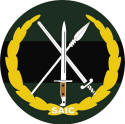
The South African Army Infantry Formation supervises all infantry within the South African Army.
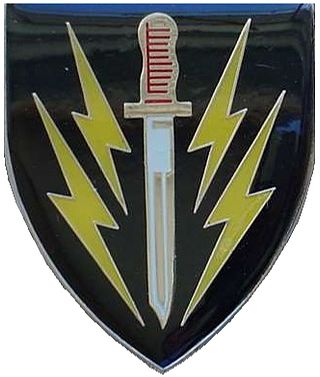
61 Mechanised Battalion Group was a unit of the South African Infantry Corps; although it was classed as mechanized infantry, it was a combined arms force consisting of infantry, armour and artillery.
A battlegroup or task force in modern military theory is the basic building block of an army's fighting force. A battlegroup is formed around an infantry battalion or armoured regiment, which is usually commanded by a lieutenant colonel. The battalion or regiment also provides the command and staff element of a battlegroup, which is complemented with an appropriate mix of armour, infantry, and support personnel and weaponry relevant to the task it is expected to perform.

Andrew Mlangeni Regiment is a reserve infantry regiment of the South African Army.

The Pretoria Armour Regiment is a reserve armoured regiment of the South African Army.
Operation Prone was a proposed military operation by the South African Defence Force (SADF) and South West African Territorial Force (SWATF) during the South African Border War and Angolan Civil War between May and September 1988. With the advance of the 50th Cuban Division towards Calueque and the South-West Africa border, the SADF formed the 10 SA Division to counter this threat. The plan for Operation Prone had two phases. Operation Linger was to be a counterinsurgency phase and Operation Pact a conventional phase.

The Myanmar Army is the largest branch of the Armed Forces (Tatmadaw) of Myanmar (Burma) and has the primary responsibility of conducting land-based military operations. The Myanmar Army maintains the second largest active force in Southeast Asia after the People's Army of Vietnam. It has clashed against ethnic and political insurgents since its inception in 1948.

Lohatla is a training area of the South African National Defence Force. It is located in the Northern Cape province of South Africa and is home to the SA Army Combat Training Centre, which is part of the South African Army Training Formation.

44 Parachute Brigade was a parachute infantry brigade of the South African Army. It was founded on 20 April 1978, by Colonel Jan Breytenbach, following the disbandment of 1 SA Corps and the battle of Cassinga. Upon formation, the brigade was commanded by Brigadier M. J. du Plessis, who was assigned the task of establishing by working with the Parachute Staff Officer, Colonel Jan Breytenbach. At the time du Plessis was the commanding officer of the Orange Free State Command and had previous experience serving in 1 Parachute Battalion. Breytenbach had also been a member of 1 Parachute Battalion and had also founded the South African Special Forces Brigade and 32 Battalion. The location that was chosen for the brigade's headquarters was in the lines of the OFS Cmd Headquarters, next to the old Tempe Airfield in Bloemfontein.
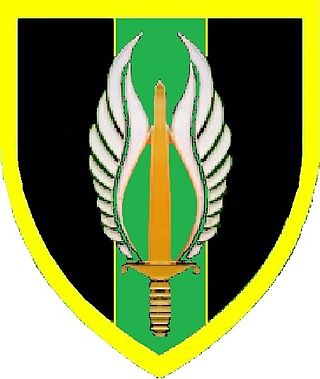
The Job Masego Regiment is a reserve mechanised infantry regiment of the South African Army.
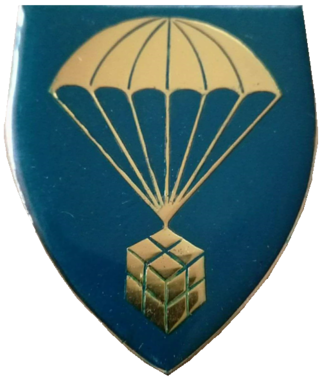
The 101 Air Supply Unit is a parachute unit of the South African Ordnance Services Corps. Formed in 1963, it has supported the 44 Parachute Brigade, now the 44 Parachute Regiment, since its establishment. It appears to be based at Lyttelton, Gauteng.

Northern Transvaal Command was a command of the South African Army. It was active from 1959 to mid 2000 when it was disestablished. Formerly it was named Northern Command from 1946 to 1959.

7 South African Infantry Division was a formation of the South African Army, active from the 1960s to 1999.

8 South African Armoured Division was a formation of the South African Army, active from the 1970s to 1999.
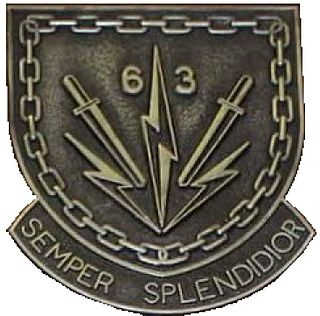
63 Mechanised Battalion Group was a unit of the South African Infantry Corps; although it was classed as mechanized infantry, it was a combined arms force consisting of infantry, armour and artillery. Together with 61 Mechanised Battalion Group and 62 Mechanised Battalion Group, these units made up 60 Brigade encompassing battlegroup principles.

Regiment Molopo was an armoured regiment of the South African Army. As a reserve unit, it had a status roughly equivalent to that of a British Army Reserve or United States Army National Guard unit.

71 Motorised Brigade was a formation of 7th South African Infantry Division, a combined arms force consisting of infantry, armour and artillery.

72 Motorised Brigade was a Formation of 7th Infantry Division, a combined arms force consisting of infantry, armour and artillery.





















